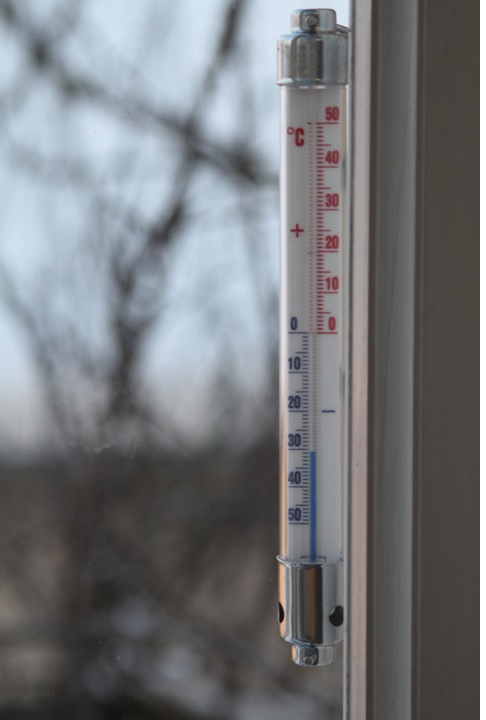Do January's cold records cancel global warming?
Mid-January this year surprised Latvia with a cold snap that hasn't been experienced in a long time. On the morning of January 17 in Staļģene, the thermometer bar dropped to minus 31 degrees Celsius. Outside my window in Ozolnieki municipality, shortly before nine in the morning, the thermometer bar dropped to minus 26.5 degrees. It was a little warmer in Riga - around minus 20 degrees.
All the euphoria created in the information space during the previous year about the seemingly endless constant heat records suddenly disappeared. For one week, Latvia was completely under the control of the Arctic air masses. The Arctic anticyclone came, and the heat records were replaced by cold records. At Jelgava observation station the lowest temperature since the history of observations was recorded on January 17.
So what determines why there are negative temperature records in one place but not elsewhere? The night from January 16 to 17 in the central part of Zemgale was completely clear and without wind. If such conditions occur during the Arctic anticyclone, then the Earth's surface and near-surface air layer can cool to record low temperatures. No ozone holes or concentration of carbon dioxide (about 0.04% in the atmosphere) will save the Earth's surface from significant cooling. The high school physics course taught that in case of heat exchange conditions for systems with different temperatures, the system with higher temperature will cool down, returning its heat energy to the material with lower temperature until the temperature differences equalize. The temperature of the cosmic vacuum is close to absolute zero. If the obstacles are minimal, the Earth's surface, even if its temperature is 250 degrees above absolute zero (that is, below minus 20 degrees Celsius), will cool so that the temperature difference equalizes. It's physics.

Although the Arctic anticyclone was still above Latvia, the night of January 18 was already warmer. Before sunrise, the thermometer outside my window showed only minus 15 degrees. Why was it ten degrees warmer that night? Because this night the central part of Zemgale was covered with a layer of slightly smoky clouds. On the night of January 19, the central part of Zemgale was already covered with a dense cover of low clouds, and the air temperature before sunrise was only minus 11 degrees. I assume that the concentration of carbon dioxide did not change much during all this time and was slightly less than 0.04%, which is the average amount of carbon dioxide in the atmosphere. The amount of clouds - the concentration of water in the near-surface layer of the atmosphere - changed. As the concentration of water in the air can reach 3%, the mass of water molecules in the air can be up to 50 times more than the mass of carbon dioxide molecules. Even if there are no clouds at zero degrees and there is 100% humidity, there will be almost ten times more water molecules per molecule of carbon dioxide in the air. Therefore, in the greenhouse effect on the Earth's surface, the amount of water in the atmosphere is the most important part, but especially how thick the cloud cover is - the amount of water vapor. It is the thickness of the cloud cover that is decisive. If the Earth is covered by clouds, then part of the Earth's surface heat flux (in the form of infrared radiation) will be absorbed and reflected from the clouds back to Earth. In this case, the thermal equilibrium will be reached at a higher temperature than if there are no clouds at all and the air is dry. Other atmospheric greenhouse gases are already much less important than water vapor.
It is not clear to me and others who once learned the basics of physics and thermodynamics (the hysterical speeches of Greta Thunberg haven't canceled any of the laws of thermodynamics) why climate hysterics completely ignore the fact that water in the atmosphere can play a hundred times greater role in causing the greenhouse effect than carbon dioxide. Of course, apart from the fact that global corporations (and the politicians and pseudo-scientists who support them) are going to make thousands of billions of euros or dollars by speculating on carbon quotas, but for cloud quotas instruments of speculation and trade have not yet been developed.
17-19 January's observations throughout Latvia show that if there are no clouds covering the Earth like a blanket, providing a greenhouse effect, then in winter, with the influx of Arctic air masses in Europe, cold records will be broken and all global warming predictions will collapse.
The answer to the question of whether the January cold records cancel something in climate change is no! Nor do heat records in 2020 cancel or change anything in climate change. Just as the cold records of January 17 are not evidence of global cooling, last year's heat records are not evidence of global warming. The air temperature on the Earth's surface is constantly changing, and within a fairly wide range, it will change even if people suddenly disappear from the Earth's surface. Climate change has been, is, and will always be, regardless of the imaginations and ambitions of influential people.